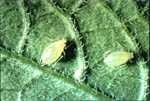Life History
The green peach aphid gives birth to live young without mating during the growing season. In response to changing daylength and cooler fall temperatures, sexual forms appear, mate and lay eggs. In Eastern Canada, early colonization of potato fields is less frequent because the green peach aphid must originate from bedding plants or overwintering sites in greenhouses. Colonization usually occurs nearer the end of the season and the aphids are thought to originate from the United States or locally from weed hosts around greenhouses or storage areas.
In late summer, winged males and females are produced, but their numbers on potato dwindle as they seek overwintering hosts. Adults may survive in storage areas.
Crop Injury The green peach aphid affects mainly the lower leaves of potato. Flowers and shoot tips are also subject to attack.
The green peach aphid is the most important vector of potato leafroll and it is an effective vector of potato virus A, potato virus S and potato virus Y.
Pest Management
It is important to manage populations of the green peach aphid in order to prevent or reduce the spread of virus diseases in the potato crop.
Monitoring - The green peach aphid is usually located on the lower leaves of potato. The technique for monitoring the abundance of this and other potato-colonizing aphids is to count the numbers of winged and wingless aphids on 100 plants chosen at random while walking in a predetermined pattern ("X" or "W") through the field. Counts are based on three compound leaves per plant, taken from the top, middle and lower parts of the plant because the different species of aphids do not distribute themselves evenly over the entire plant.
In general, determination of the need for control is based on the occurrence of sudden and significant increases in the abundance of the green peach aphid on potato plants or in monitoring traps. Traps provide information that can be related to the dispersal and redistribution of aphids. Because yellow traps attract aphids, they are used to monitor the time of aphid flights.
The empirically established threshold for the green peach aphid on potato in New Brunswick is 25 aphids per 3 compound leaves per plant, and 10% of all plants infested until mid- to late August, after which time control is usually no longer required. In areas where seed potato crops are grown, topkilling is recommended as soon as possible after the onset of flights of the green peach aphid. As an indication of when leafroll may begin to spread within the crop, New Brunswick uses a threshold of five cumulative catches in any yellow water-pan trap during the season.
Cultural Practices - To prevent or reduce the spread of virus diseases or to eliminate infection, growers should plant only certified seed, rogue early and topkill as soon as possible after aphid flights begin. Topkilling should be done as early as tuber maturity allows in order to limit the spread of virus diseases.
Chemical Control - To keep field populations of the green peach aphid low, thereby preventing the formation of winged forms that might otherwise spread virus diseases, growers usually have to apply chemical insecticides. In areas where early colonization from overwintering hosts or greenhouse colonies are likely, a systemic insecticide at planting will be effective for seven weeks or longer. This sometimes eliminates the need for further control measures.

